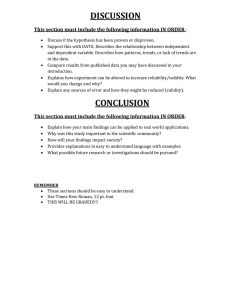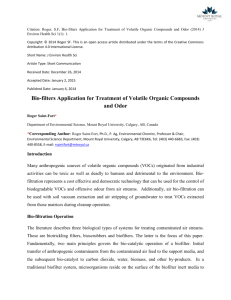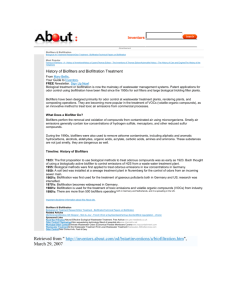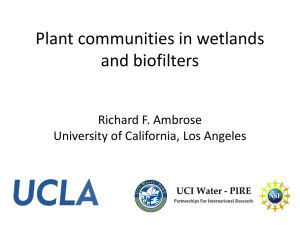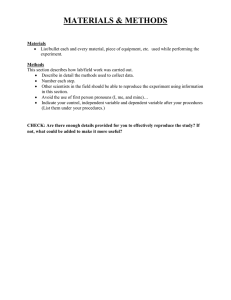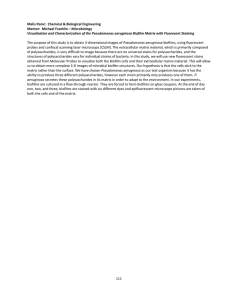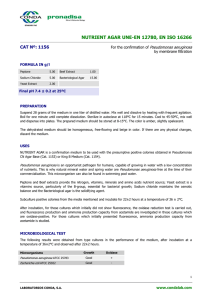Introduction References
advertisement
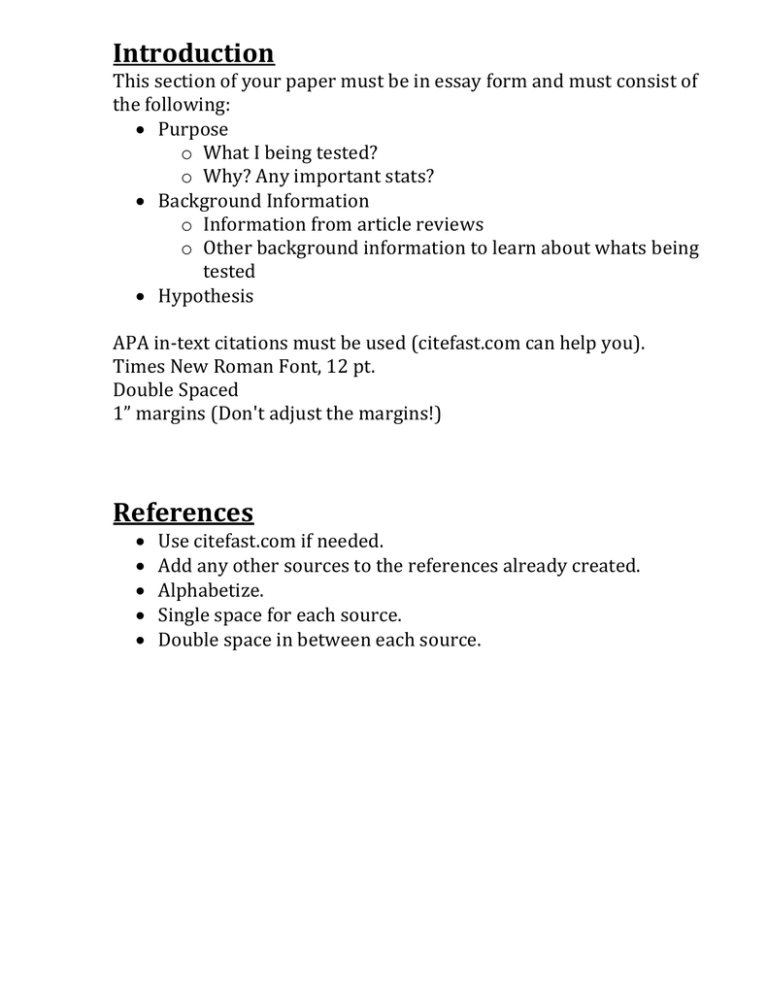
Introduction This section of your paper must be in essay form and must consist of the following: Purpose o What I being tested? o Why? Any important stats? Background Information o Information from article reviews o Other background information to learn about whats being tested Hypothesis APA in-text citations must be used (citefast.com can help you). Times New Roman Font, 12 pt. Double Spaced 1” margins (Don't adjust the margins!) References Use citefast.com if needed. Add any other sources to the references already created. Alphabetize. Single space for each source. Double space in between each source. SAMPLE Introduction The purpose of this experiment is to test how effectively biofiltration reduces harmful air pollutants? Currently global air pollution is soaring. With rapid industrialization occurring in areas around the world to supply the demand of the technological era, pollutants are entering the atmosphere at rates much higher than before. While many argue the idea that one should focus merely on the reduction of carbon dioxide emissions, other organic compounds present in the atmosphere not only trap ultraviolet rays at a much higher rate than carbon dioxide, but are the main precursor to the increasing number of allergy, asthma, and cancer patients. While many methods have been developed in attempt to reduce the number of emission created, few have been cost effective. The search for a solution is still continuing (Environmental Protection Agency, n.d.). Biofiltration is one of the main developing methods used in reducing certain organic compounds. The process of biofiltration merely uses a biofilter chamber which is composed of a certain type of bacteria along with a type of filter media such as soil or compost to reduce air pollution (North Carolina State University. 2012). The filter media serves as a location for the bacteria to reside in efforts to form a biofilm, or a group of bacterial colonies. Because certain types of bacteria naturally break down organic compounds in order to carry out respiration, the biofilter encloses these microorganisms in an area in which they are given air containing organic compounds that are detrimental to humans (The Biofilms Hypertextbook, n.d.). After cellular respiration takes place the end products are less harmful to the environment overall. The end products however do vary based on the type of bacteria (Center for Biofilm Engineering, n.d.). The design and structure of a biofilter varies greatly as well. While some biofilters are used in the reduction of air pollution, others can be designed differently to be used in the reduction of water and soil pollution. The use of biofilters however is still debated. While many advantages include the biofilter’s ability to be altered to reduce different types of pollution, a lower cost than other methods, commercial applications, and the efficient reduction of volatile organic compounds under 1000 ppm, many believe that the amount of space a biofilter takes up is too vast. Also, the biofilter is unable to deal with chlorinated compounds and efficiency rates vary based on how well the bacteria adapts to the air and how quickly the bacterial colonies form. Yet, biofilters have been used industrially in the chemical, petrochemical, pharmaceutical, oil and gas industry. Biofilters have also been used commercially in factories that produce synthetic resins, dyes, paint and ink. Large scale biofiltration of soil and groundwater has also occurred. (Anit Artruz. n.d.). Specifically, Pseudomonas aeruginosa has been used in many biofilters (Morales, Revah, Salazar, 2012). Commonly found in soil and water, this species of bacteria has very simple nutritional requirements. Since it does not need to be grown in the presence of oxygen, it is a very good candidate for biofiltraton (Ferrera, Mas, Sanchez, 2007). It has been stated that Pseudomonas aeruginosa can use over seventy five organic compounds for proper growth, some of which pollute today’s current atmosphere. While this bacteria is resistant to many conditions, its optimal growth temperature is 37 degrees Celsius. Pseudomonas aeruginosa is said to work best in moist environments. Physically, this bacteria moves around using is flagellum, and is noted as one of the fastest moving microorganisms in pond water. When forming colonies, three distinct types can be seen. The first type is usually small and rough. This sample is usually obtained from soil and water samples. When collected clinically however, a smoother rounded colony is seen. Since Pseudomonas aeruginosa is the cause of many urinary tract infections, these samples that are collected from the human body are rather distinct in shape compared to the ones found in the environment (Todar, n.d.). Two main chemicals reduced in biofilters are benzene and toluene. Both of these substances have been classified as volatile organic compounds, meaning they “are emitted as gases from certain solids or liquids. VOCs include a variety of chemicals, some of which may have short- and long-term adverse health effects” (Environmental Protection Agency, n.d). Benzene, which has a chemical composition of C6H6 is used industrially to produce glues, adhesives, cleaning products, paint strippers, tobacco smoke, gasoline, elastics, resins, synthetic fibers, rubber lubricants, dyes, detergents, drugs and pesticides (Center for Disease Control and Prevention, 2013). Toluene is also use industrially as it is added to gasoline and used to make chemicals such as benzene. Toluene is also used in the production of paint thinner dyes, inks, and resins (Environmental Protection Agency, 1982). Hypothesis: The hypothesis is that group that contains the biofilter will most likely have a lower concentration of both benzene and toluene than the group without the biofilter. This is because the Pseudomonas Aeruginosa used in the biofilter will use both benzene and toluene during as reactants during respiration as shown in studies by Ferrera, Mas, and Sanchez in 2007. The product of the reaction will most likely be less harmful than the original reactants, resulting in a smaller concentration of both benzene and toluene in the group containing the biofilter, which was concluded in the 2007 study by Ferrera, Mas, and Sanchez as well. Since the control group had no means of reducing air pollution other than diffusion of the chemicals into the atmosphere, it will most likely have a higher concentration of benzene and toluene. Other studies, conducted by Anit and Artruz as well as Ferrera, Mas, and Sanchez in 2007, have also supported the use of biofilters containing Pseudomonas Aeruginosa. These studies have resulted in a reduction of toluene and other hydrocarbon compounds such as benzene. A more recent study in 2012 conducted by Morales, Revah, and Salazar also supported the idea of efficient Pseudomonas Aeruginosa biofiltration. References A Brief Introduction to Biofilms. (n.d.). In homepage. Retrieved from http://www.hypertextbookshop.com/biofilmbook/v004/r003/contents/chapters/chapter001/sect ion002/green/page001.html Acuna, M. E., Perez, F., Revah, S., & Auria, R. (1999). Microbiological and kinetic aspects of a biofilter for the removal of toluene from waste gases. Biotechnology and Bioengineering. doi:10.1002/(SICI)1097-0290(19990420)63:23.0.CO Advantages and Disadvantages of Biofiltration. (n.d.). Retrieved from http://www.rpi.edu/dept/chem-eng/BiotechEnviron/MISC/biofilt/biofiltration.htm#ADVANTAGES AND DISADVATAGES OF BIOFILTRATION Ferrera, I., Sánchez, O., & Mas, J. (2004). A new non-aerated illuminated packed-column reactor for the development of sulfide-oxidizing biofilms. Applied Microbiology and Biotechnology. doi:10.1007/s00253-004-1581-y Montana State University (n.d.). Biofilm basics: Section 3 | Center for Biofilm Engineering. Retrieved from http://www.biofilm.montana.edu/node/2409 Pseudomonas. (n.d.). In Online Textbook of Bacteriology. Retrieved from http://textbookofbacteriology.net/pseudomonas_2.html Salazar, M., Morales, M., & Revah, S. (2012). Biodegradation of methyl tert-butyl ether by cometabolism with hexane in biofilters inoculated with Pseudomonas aeruginosa. Journal of Environmental Science and Health Part A-toxic/hazardous Substances & Environmental Engineering. doi:10.1080/10934529.2012.667319 Toluene | Technology Transfer Network Air Toxics Web site | US EPA. (n.d.). Retrieved from http://www.epa.gov/ttn/atw/hlthef/toluene.html Volatile Organic Compounds | Indoor Air | US Environmental Protection Agency. (n.d.). Retrieved from http://www.epa.gov/iaq/voc.html
